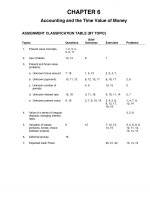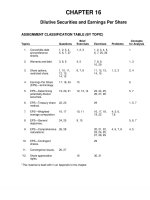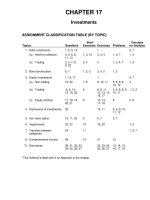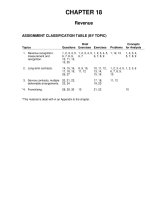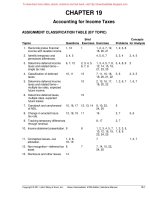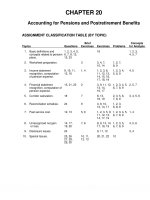Intermediate accounting IFRS 3rd ch06
Bạn đang xem bản rút gọn của tài liệu. Xem và tải ngay bản đầy đủ của tài liệu tại đây (3.75 MB, 84 trang )
Prepared by
Coby Harmon
University of California, Santa Barbara
Westmont College
6-1
Accounting and the
Time Value of Money
CHAPTER 6
LEARNING
LEARNINGOBJECTIVES
OBJECTIVES
After studying this chapter, you should be able to:
6-2
1.
Describe the fundamental
concepts related to the time
value of money.
4.
Solve present value of
ordinary and annuity due
problems.
2.
Solve future and present value
of 1 problems.
5.
3.
Solve future value of ordinary
and annuity due problems.
Solve present value
problems related to deferred
annuities, bonds, and
expected cash flows.
PREVIEW OF CHAPTER 6
6-3
Intermediate Accounting
IFRS 3rd Edition
Kieso ● Weygandt ● Warfield
Basic
Basic Time
Time
Value
Value Concepts
Concepts
LEARNING OBJECTIVE 1
Describe the fundamental
concepts r elated to the time
value of money.
Time Value of Money
A relationship between time and money.
A dollar received today is worth more than a dollar
promised at some time in the future.
When
When deciding
deciding among
among investment
investment or
or borrowing
borrowing
alternatives,
alternatives, itit is
is essential
essential to
to be
be able
able to
to compare
compare
today’s
today’s dollar
dollar and
and tomorrow’s
tomorrow’s dollar
dollar on
on the
the same
same
footing—to
footing—to “compare
“compare apples
apples to
to apples.”
apples.”
6-4
LO 1
Basic Time Value Concepts
Applications of Time Value Concepts:
1. Notes
2. Leases
3. Pensions and Other
Postretirement
Benefits
5. Shared-Based
Compensation
6. Business Combinations
7. Disclosures
8. Environmental Liabilities
4. Non-Current Assets
6-5
LO 1
Basic Time Value Concepts
The Nature of Interest
Payment for the use of money.
Excess cash received or repaid over the amount lent
or borrowed (principal).
Variables in Interest Computation
1. Principal. The amount borrowed or invested.
2. Interest Rate. A percentage of the outstanding principal.
3. Time. The number of years or fractional portion of a year that the
principal is outstanding.
6-6
LO 1
Basic Time Value Concepts
Simple Interest
Interest computed on the principal only.
Illustration: Barstow Electric Inc. borrows $10,000 for 3 years
at a simple interest rate of 8% per year. Compute the total
interest to be paid for 1 year.
Interest = p x i x n
Annual
Interest
= $10,000 x .08 x 1
= $800
6-7
LO 1
Basic Time Value Concepts
Simple Interest
Interest computed on the principal only.
Illustration: Barstow Electric Inc. borrows $10,000 for 3 years
at a simple interest rate of 8% per year. Compute the total
interest to be paid for 3 years.
Interest = p x i x n
Total
Interest
= $10,000 x .08 x 3
= $2,400
6-8
LO 1
Basic Time Value Concepts
Simple Interest
Interest computed on the principal only.
Illustration: If Barstow borrows $10,000 for 3 months at a 8%
per year, the interest is computed as follows.
Partial
Year
Interest = p x i x n
= $10,000 x .08 x 3/12
= $200
6-9
LO 1
Basic Time Value Concepts
Compound Interest
6-10
Computes interest on
►
principal and
►
interest earned that has not been paid or
withdrawn.
Typical interest computation applied in business
situations.
LO 1
Compound Interest
Illustration: Tomalczyk Company deposits $10,000 in the Last National
Bank, where it will earn simple interest of 9% per year. It deposits another
$10,000 in the First State Bank, where it will earn compound interest of
9% per year compounded annually. In both cases, Tomalczyk will not
withdraw any interest until 3 years from the date of deposit.
Year 1 $10,000.00 x 9%
$ 900.00
$ 10,900.00
Year 2 $10,900.00 x 9%
$ 981.00
$ 11,881.00
Year 3 $11,881.00 x 9%
ILLUSTRATION 6.1
Simple vs. Compound Interest
6-11
$1,069.29 $ 12,950.29
LO 1
Basic Time Value Concepts
Compound Interest Tables
Table 6.1 - Future Value of 1
Table 6.2 - Present Value of 1
Table 6.3 - Future Value of an Ordinary Annuity of 1
Table 6.4 - Present Value of an Ordinary Annuity of 1
Table 6.5 - Present Value of an Annuity Due of 1
Number of Periods = number of years x the number of compounding
periods per year.
Compounding Period Interest Rate = annual rate divided by the
number of compounding periods per year.
6-12
LO 1
Basic Time Value Concepts
Compound Interest Tables
ILLUSTRATION 6.2
Excerpt from Table 6.1
How much principal plus interest a dollar accumulates to at the end of
each of five periods, at three different rates of compound interest.
6-13
LO 1
Basic Time Value Concepts
Compound Interest Tables
Formula to determine the future value factor (FVF) for 1:
Where:
FVFn,i = future value factor for n periods at i interest
n
i
6-14
= number of periods
= rate of interest for a single period
LO 1
Basic Time Value Concepts
Compound Interest Tables
To illustrate the use of interest tables to calculate compound
amounts, Illustration 6.3 shows the future value to which 1
accumulates assuming an interest rate of 9%.
*Note that these amounts appear in Table 6.1 in the 5% column.
ILLUSTRATION 6.3
Accumulation of Compound Amounts
6-15
LO 1
Basic Time Value Concepts
Compound Interest Tables
Number of years X number of compounding periods per year =
Number of periods
ILLUSTRATION 6.4
Frequency of
Compounding
6-16
LO 1
Basic Time Value Concepts
Compound Interest Tables
A 9% annual interest compounded daily provides a 9.42% yield.
Effective Yield for a $10,000 investment.
ILLUSTRATION 6.5
Comparison of Different Compounding Periods
6-17
LO 1
Basic Time Value Concepts
Fundamental Variables
Rate of Interest
Future Value
Number of Time Periods
Present Value
ILLUSTRATION 6.6
Basic Time Diagram
6-18
LO 1
Single-Sum Problems
LEARNING OBJECTIVE 2
Solve future and present value
of 1 problems.
Two Categories
Unknown Present Value
Unknown Future Value
ILLUSTRATION 6.6
Basic Time Diagram
6-19
LO 2
Single-Sum Problems
Future Value of a Single Sum
Value at a future date of a given amount invested, assuming
compound interest.
Where:
FV = future value
PV = present value (principal or single sum)
FVF n,i = future value factor for n periods at i interest
6-20
LO 2
Future Value of a Single Sum
Illustration: Bruegger AG wants to determine the future value
of €50,000 invested for 5 years compounded annually at an
interest rate of 6%.
ILLUSTRATION 6.7
Future Value Time
Diagram (n = 5, i = 6%)
= €66,912
6-21
LO 2
Future Value of a Single Sum
Alternate
Calculation
Illustration: Bruegger AG wants to determine the future value
of €50,000 invested for 5 years compounded annually at an
interest rate of 6%.
ILLUSTRATION 6.7
Future Value Time
Diagram (n = 5, i = 11%)
6-22
What table
do we use?
LO 2
Future Value of a Single Sum
Alternate
Calculation
TABLE 6.1 FUTURE VALUE OF 1 (FUTURE VALUE OF A SINGLE SUM)
i=6%
n=5
What factor do we use?
€50,000
Present Value
6-23
x
1.33823
Factor
=
€66,912
Future Value
LO 2
Future Value of a Single Sum
Illustration: Shanghai Electric Power (CHN) deposited
¥250 million in an escrow account with Industrial and Commercial
Bank of China (CHN) at the beginning of 2019 as a commitment
toward a power plant to be completed December 31, 2022. How
much will the company have on deposit at the end of 4 years if
interest is 10%, compounded semiannually?
ILLUSTRATION 6.8
Future Value Time
Diagram (n = 8, i = 5%)
6-24
What table do we use?
LO 2
Future Value of a Single Sum
TABLE 6.1 FUTURE VALUE OF 1 (FUTURE VALUE OF A SINGLE SUM)
¥250,000,000
Present Value
6-25
x
1.47746
Factor
=
i=5%
n=8
¥369,365,000
Future Value
LO 2



